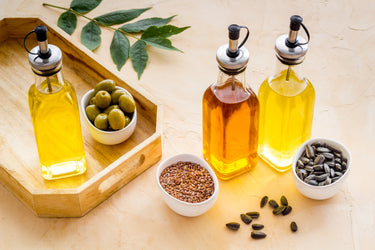4 Cooking Oils Worth Trying

Stocking your cabinet with more than just olive oil is an easy way to bring new excitement to your cooking. From the subtle, nutty notes of sesame oil to health-promoting flaxseed oil, these 4 cooking oils are easy to find in your local grocery store and useful for everyday cooking. Oils are best stored in a cool, dark place like a kitchen cabinet that isn’t hit by direct sunlight. Make sure the lid is tightly screwed on to avoid oxidization, which can lead to rancidity. Even though it’s handy to keep a bottle by the stove, exposure to sunlight and heat can cause the oils to go rancid.
Sesame Oil
Sesame oil (aka sesame seed oil) is made from pressed sesame seeds, which you can find in toasted and raw versions. The toasted boosts a stronger, nuttier flavor than the plain kind, which is neutral and mild. Many people swear by refrigerating sesame oils, but you can also store them in a cool, dark place.
What to use it for: Raw sesame oil (which is just called sesame oil in stores) has a high smoke point (410 to 446ºF), which makes it great for high-heat cooking. Use sesame seed oil in place of other oils that are good for high heat (like canola, vegetable, or sunflower), like stir-fries, to marinade steaks or chicken thighs before grilling, or to cook potstickers. Toasted sesame oil is better for raw preparations or for drizzling on as a garnish, since it has a lower smoke point. Use it for salad dressings, to finish a cold soup, or to season a cold noodle salad. If you love tahini, then you’ll love the depth of flavor that toasted sesame oil adds to your dishes.
Flaxseed Oil (Aka Linseed Oil)
Pressed from raw flaxseeds, this oil has a golden-yellow color and has a mild, slightly nutty flavor. This oil is packed with potassium and omega-3 fatty acids and is touted as able to reduce cholesterol and blood sugar. Though people often take flaxseed oil in capsules, it’s worth trying it in your cooking, instead.
What to use it for: Because flaxseed oil has a low smoke point (around 225ºF) it’s best used for raw preparations. Stir it into salad dressings, add it to potato salad, drizzle over baked fish, or swap it in for some of the olive oil in pesto, chimichurri, or other fresh herb sauces. Too much of the stuff can add a fishy flavor to dishes, so either pair it with seafood or use it sparingly.
Peanut Oil
The process of making refined peanut oil includes blanching and deodorizing the peanuts, which typically makes it safe for people with peanut allergies. Its high smoke point and neutral flavor makes refined peanut oil a common pick in restaurants for deep fried dishes like french fries and battered food. Unrefined peanut oil is made by pressing raw peanuts to extract oil. Peanut oil has a combination of saturated and unsaturated fats, which make it a better pick for occasional cooking if you are watching saturated fat.
What to use it for: The refined version has a high smoke point (around 450º) and a neutral flavor, making it perfect for fried chicken, grilled vegetables, or anytime you want to crank up the heat. Unrefined peanut oil boasts a nuttier flavor ideal for salad dressings, marinades, or in low-heat cooking preparations. Try making homemade chili oil with unrefined peanut oil. Infuse it with sliced chili peppers and/or dried chilies, then drizzle over fried eggs, cooked meats, or cold noodles.
Avocado Oil
This brain-friendly oil is rich in monounsaturated fats and has a neutral flavor. You won’t notice that it comes from avocados—the flavor is neutral and mild, making it a great pick for a variety of dishes. After pressing the flesh, seeds, skin and all, the oil is then filtered to remove impurities. Because of its higher smoke point, avocado oil is a great swap for olive oil for high-heat applications.
What to use it for: Stable at very high temperatures (up to 520ºF), avocado oil is a good pick for roasting, frying, grilling and other high-heat applications. Choose it where you’d pick canola oil, vegetable oil, or even olive oil. Just because it’s great at such high temperatures doesn’t mean it isn’t good in raw dishes, too. Try avocado oil in a homemade mayonnaise, instead of butter on homemade popcorn, or to drizzle over—what else?—avocado toast.





